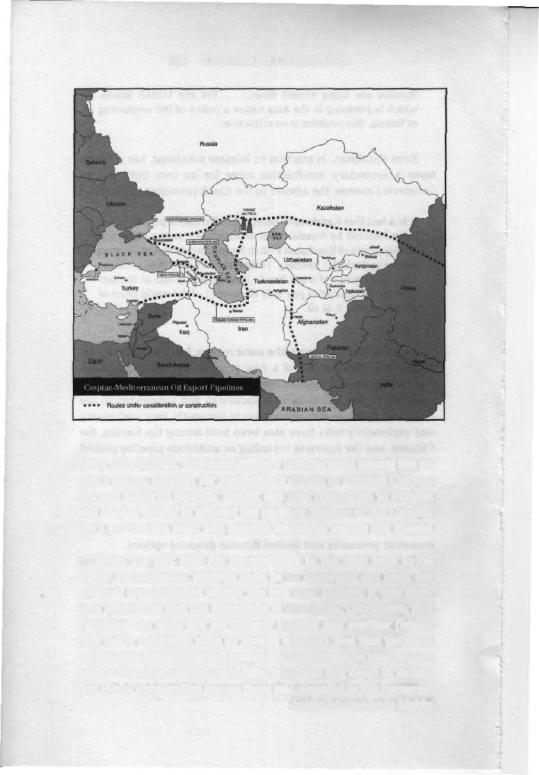
Grand_Chessboard
.pdf
THE EURASIAN BALKANS 143
however, Russia's policy toward the Central Asian states and the Caucasus is much more reminiscent of the Francophone African community—with the French military contingents and budgetary subsidies determining the politics and policies of the Frenchspeaking postcolonial African states.
While the restoration of the maximum feasible degree of Russian political and economic influence in the region is the overall goal and the reinforcement of the CIS is the principal mechanism for achieving it, Moscow's primary geopolitical targets for political subordination appear to be Azerbaijan and Kazakstan. For a Russian political counteroffensive to be successful, Moscow must not only cork access to the region but must also penetrate its geographic shield.
For Russia, Azerbaijan has to be a priority target. Its subordination would help to seal off Central Asia from the West, especially from Turkey, thereby further increasing Russia's leverage vis-a-vis the recalcitrant Uzbekistan and Turkmenistan. To that end, tactical cooperation with Iran regarding such controversial issues as how to divide the drilling concessions to the Caspian seabed serves the important objective of compelling Baku to accommodate itself to Moscow's wishes. A subservient Azerbaijan would also facilitate the consolidation of a dominant Russian position in both Georgia and Armenia.
Kazakstan offers an especially tempting primary target as well, because its ethnic vulnerability makes it impossible for the Kazak government to prevail in an open confrontation with Moscow. Moscow can also exploit the Kazak fear of China's growing dynamism, as well as the likelihood of growing Kazak resentment over the Sinification of the adjoining Xinjiang Province in China. Kazakstan's gradual subordination would have the geopolitical effect of almost automatically drawing Kyrgyzstan and Tajikistan into Moscow's sphere of control, while exposing both Uzbekistan and Turkmenistan to more direct Russian pressure.
The Russian strategy, however, runs counter to the aspirations of almost all of the states located in the Eurasian Balkans. Their new political elites will not voluntarily yield the power and privilege they have gained through independence. As the local Russians gradually vacate their previously privileged positions, the new elites are rapidly developing a vested interest in sovereignty, a

144 THE GRAND CHESSBOARD
dynamic and socially contagious process. Moreover, the once politically passive populations are also becoming more nationalistic and, outside of Georgia and Armenia, also more conscious of their Islamic identity.
Insofar as foreign affairs are concerned, both Georgia and Armenia (despite the latter's dependence on Russian support against Azerbaijan) would like to become gradually more associated with Europe. The resource-rich Central Asian states, along with Azerbaijan, would like to maximize the economic presence on their soil of American, European, Japanese, and lately Korean capital, hoping thereby to greatly accelerate their own economic development and consolidate their independence. To this end, they also welcome the increasing role of Turkey and Iran, seeing in them a counterweight to Russian power and a bridge to the large Muslim world to the south.
Azerbaijan—encouraged by both Turkey and America—has thus not only rejected Russian demands for military bases but it also defied Russian demands for a single pipeline to a Russian Black Sea port, opting instead for a dual solution involving a second pipeline through Georgia to Turkey. (A pipeline southward through Iran, to be financed by an American company, had to be abandoned because of the U.S. financial embargo on deals with Iran.) In 1995, amid much fanfare, a new rail link between Turkmenistan and Iran was opened, making it feasible for Europe to trade with Central Asia by rail, skirting Russia altogether. There was a touch of symbolic drama to this reopening of the ancient Silk Route, with Russia thus no longer able to separate Europe from Asia.
Uzbekistan has also become increasingly assertive in its opposition to Russia's efforts at "integration." Its foreign minister declared flatly in August 1996 that "Uzbekistan opposes the creation of CIS supranational institutions which can be used as instruments of centralized control." Its strongly nationalistic posture had already prompted sharp denunciations in the Russian press concerning Uzbekistan's
emphatically pro-West orientation in the economy, the harsh invective apropos integration treaties within the CIS, the decisive refusal to join even the Customs Union, and a methodical anti-Russian nationality policy (even kindergartens which use

THE EURASIAN BALKANS 145
Russian are being closed down). ... For the United States, which is pursuing in the Asia region a policy of the weakening of Russia, this position is so attractive.1
Even Kazakstan, in reaction to Russian pressures, has come to favor a secondary non-Russian route for its own outflows. As Umirserik Kasenov, the adviser to the Kazak president, put it:
It is a fact that Kazakstan's search for alternative pipelines has been fostered by Russia's own actions, such as the limitation of shipments of Kazakstan's oil to Novorossiysk and of Tyumen oil to the Pavlodar Refinery. Turkmenistan's efforts to promote the construction of a gas line to Iran are partly due to the fact that the CIS countries pay only 60 percent of the world price or do not pay for it at all.2
Turkmenistan, for much the same reason, has been actively exploring the construction of a new pipeline through Afghanistan and Pakistan to the Arabian Sea, in addition to the energetic construction of new rail links with Kazakstan and Uzbekistan to the north and with Iran and Afghanistan to the south. Very preliminary and exploratory talks have also been held among the Kazaks, the Chinese, and the Japanese regarding an ambitious pipeline project that would stretch from Central Asia to the China Sea (see map on page 146). With long-term Western oil and gas investment commitments in Azerbaijan reaching some $13 billion and in Kazakstan going well over $20 billion (1996 figures), the economic and political isolation of this area is clearly breaking down in the face of global economic pressures and limited Russian financial options.
Fear of Russia has also had the effect of driving the Central Asian states into greater regional cooperation. The initially dormant Central Asian Economic Union, formed in January 1993, has been gradually activated. Even President Nursultan Nazarbayev of Kazakstan, at first an articulate advocate of a new "Eurasian Union," gradually became a convert to ideas of closer Central
lZavtm28(June1996).
iUWhat Russia Wants in the Transcaucasus and Central Asia," NezavisimayaGazeta,January24,1995.

146 THE GRAND CHESSBOARD
Asian cooperation, increased military collaboration among the region's states, support for Azerbaijan's efforts to channel Caspian Sea and Kazak oil through Turkey, and joint opposition to Russian and Iranian efforts to prevent the sectoral division of the Caspian Sea's continental shelf and mineral resources among the coastal states.
Given the fact that the governments in the area tend to be highly authoritarian, perhaps even more important has been the personal reconciliation among the principal leaders. It was common knowledge that the presidents of Kazakstan, Uzbekistan, and Turkmenistan were not particularly fond of one another (which they made eminently plain to foreign visitors), and that personal antagonism initially made it easier for the Kremlin to play off one against the other. By the mid-1990s, the three had come to realize that closer cooperation among them was essential to the preservation of their new sovereignty, and they began to engage in highly

THE EURASIAN BALKANS 147
publicized displays of their allegedly close relations, stressing that henceforth they would coordinate their foreign policies.
But more important still has been the emergence within the CIS of an informal coalition, led by Ukraine and Uzbekistan, dedicated to the idea of a "cooperative," but not "integrated," commonwealth. Toward this end, Ukraine has signed agreements on military cooperation with Uzbekistan, Turkmenistan, and Georgia; and in September 1996, the foreign ministers of Ukraine and Uzbekistan even engaged in the highly symbolic act of issuing a declaration, demanding that henceforth CIS summits not be chaired by Russia's president but that the chairmanship be rotated.
The example set by Ukraine and Uzbekistan has had an impact even on the leaders who have been more deferential to Moscow's central concerns. The Kremlin must have been especially disturbed to hear Kazakstan's Nursultan Nazarbayev and Georgia's Eduard Shevardnadze declare in September 1996 that they would leave the CIS "if our independence is threatened." More generally, as a counter to the CIS, the Central Asian states and Azerbaijan stepped up their level of activity in the Organization of Economic Cooperation, a still relatively loose association of the region's Islamic states—including Turkey, Iran, and Pakistan—dedicated to the enhancement of financial, economic, and transportation links among its members. Moscow has been publicly critical of these initiatives, viewing them, quite correctly, as diluting the pertinent states' membership in the CIS.
In a similar vein, there has been steady enhancement of ties with Turkey and, to a lesser extent, Iran. The Turkic-speaking countries have eagerly accepted Turkey's offers of military training for the new national officer corps and the laying down of the Turkish welcome mat for some ten thousand students. The fourth summit meeting of the Turkic-speaking countries, held in Tashkent in October 1996 and prepared with Turkish backing, focused heavily on the enhancement of transportation links, on increased trade, and also on common educational standards as well as closer cultural cooperation with Turkey. Both Turkey and Iran have been particularly active in assisting the new states with their television programming, thereby directly influencing large audiences.
A ceremony in Alma-Ata, the capital of Kazakstan, in December 1996 was particularly symbolic of Turkey's identification with the

148 THE GRAND CHESSBOARD
independence of the region's states. On the occasion of the fifth anniversary of Kazakstan's independence, the Turkish president, Suleyman Demirel, stood at the side of President Nazarbayev at the unveiling of a gold-colored column twenty-eight meters high, crowned with a legendary Kazak/Turkic warrior's figure atop a griffinlike creature. At the event, Kazakstan hailed Turkey for "standing by Kazakstan at every step of its development as an independent state," and the Turks reciprocated by granting Kazakstan a credit line of $300 million, beyond existing private Turkish investment of about $1.2 billion.
While neither Turkey nor Iran has the means to exclude Russia from regional influence, Turkey and (more narrowly) Iran have thus been reinforcing the will and the capacity of the new states to resist reintegration with their northern neighbor and former master. And that certainly helps to keep the region's geopolitical future open,
NEITHER DOMINION NOR EXCLUSION
The geostrategic implications for America are clear: America is too distant to be dominant in this part of Eurasia but too powerful not to be engaged. All the states in the area view American engagement as necessary to their survival. Russia is too weak to regain imperial domination over the region or to exclude others from it, but it is also too close and too strong to be excluded. Turkey and Iran are strong enough to be influential, but their own vulnerabilities could make the area unable to cope with both the challenge from the north and the region's internal conflicts. China is too powerful not to be feared by Russia and the Central Asian states, yet its very presence and economic dynamism facilitates Central Asia's quest for wider global outreach.
It follows that America's primary interest is to help ensure that no single power comes to control this geopolitical space and that the global community has unhindered financial and economic access to it. Geopolitical pluralism will become an enduring reality only when a network of pipeline and transportation routes links the region directly to the major centers of global economic activity via the Mediterranean and Arabian Seas, as well as overland.

THE EURASIAN BALKANS 149
Hence, Russian efforts to monopolize access need to be opposed as inimical to regional stability.
However, the exclusion of Russia from the area is neither desirable nor feasible, nor is the fanning of hostility between the area's new states and Russia. In fact, Russia's active economic participation in the region's development is essential to the area's stabil- ity—and having Russia as a partner, but not as an exclusive dominator, can also reap significant economic benefits as a result. Greater stability and increased wealth within the region would contribute directly to Russia's well-being and give real meaning to the "commonwealth" promised by the acronym CIS. But that cooperative option will become Russia's policy only when much more ambitious, historically anachronistic designs that are painfully reminiscent of the original Balkans are effectively precluded.
The states deserving America's strongest geopolitical support are Azerbaijan, Uzbekistan, and (outside this region) Ukraine, all three being geopolitically pivotal. Indeed, Kiev's role reinforces the argument that Ukraine is the critical state, insofar as Russia's own future evolution is concerned. At the same time, Kazakstan—given its size, economic potential, and geographically important loca- tion—is also deserving of prudent international backing and especially of sustained economic assistance. In time, economic growth in Kazakstan might help to bridge the ethnic split that makes this Central Asian "shield" so vulnerable to Russian pressure.
In this region, America shares a common interest not only with a stable, pro-Western Turkey but also with Iran and China. A gradual improvement in American-Iranian relations would greatly increase global access to the region and, more specifically, reduce the more immediate threat to Azerbaijan's survival. China's growing economic presence in the region and its political stake in the area's independence are also congruent with America's interests. China's backing of Pakistan's efforts in Afghanistan is also a positive factor, for closer Pakistani-Afghan relations would make international access to Turkmenistan more feasible, thereby helping to reinforce both that state and Uzbekistan (in the event that Kazakstan were to falter).
Turkey's evolution and orientation are likely to be especially decisive for the future of the Caucasian states. If Turkey sustains its path to Europe—and if Europe does not close its doors to

150 THE GRAND CHESSBOARD
Turkey—the states of the Caucasus are also likely to gravitate into the European orbit, a prospect they fervently desire. But if Turkey's Europeanization grinds to a halt, for either internal or external reasons, then Georgia and Armenia will have no choice but to adapt to Russia's inclinations. Their future will then become a function of Russia's own evolving relationship with the expanding Europe, for good or ill.
Iran's role is likely to be even more problematic. A return to a pro-Western posture would certainly facilitate the stabilization and consolidation of the region, and it is therefore strategically desirable for America to encourage such a turn in Iran's conduct. But until that happens, Iran is likely to play a negative role, adversely affecting Azerbaijan's prospects, even as it takes positive steps like opening Turkmenistan to the world and, despite Iran's current fundamentalism, reinforcing the Central Asians' sense of their religious heritage.
Ultimately, Central Asia's future is likely to be shaped by an even more complex set of circumstances, with the fate of its states determined by the intricate interplay of Russian, Turkish, Iranian, and Chinese interests, as well as by the degree to which the United States conditions its relations with Russia on Russia's respect for the independence of the new states. The reality of that interplay precludes either empire or monopoly as a meaningful goal for any of the geostrategic players involved. Rather, the basic choice is between a delicate regional balance—which would permit the gradual inclusion of the area in the emerging global economy while the states of the region consolidate themselves and probably also acquire a more pronounced Islamic identity—or ethnic conflict, political fragmentation, and possibly even open hostilities along Russia's southern frontiers. The attainment and consolidation of that regional balance has to be a major goal in any comprehensive U.S. geostrategy for Eurasia.

CHAPTER 6
The
Far Eastern
Anchor
AN EFFECTIVE AMERICAN POLICY for Eurasia has to have a Far Eastern anchor. That need will not be met if America is excluded or excludes itself from the Asian mainland. A close relationship with maritime Japan is essential for America's global policy, but a cooperative relationship with mainland China is imperative for America's Eurasian geostrategy. The implications of that reality need to be faced, for the ongoing interaction in the Far East between three major powers—America, China, and Japan— creates a potentially dangerous regional conundrum and is almost
certain to generate geopolitically tectonic shifts.
For China, America across the Pacific should be a natural ally since America has no designs on the Asian mainland and has historically opposed both Japanese and Russian encroachments on a weaker China. To the Chinese, Japan has been the principal enemy over the last century; Russia, "the hungry land" in Chinese, has long been distrusted; and India, too, now looms as a potential rival. The principle "my neighbor's neighbor is my ally" thus fits the geopolitical and historical relationship between China and America.
151

152 THE GRAND CHESSBOARD
However, America is no longer Japan's adversary across the ocean but is now closely allied with Japan. America also has strong ties with Taiwan and with several of the Southeast Asian nations. The Chinese are also sensitive to America's doctrinal reservations regarding the internal character of the current Chinese regime. Thus, America is also seen as the principal obstacle in China's quest not only to become globally preeminent but even just regionally predominant. Is a collision between America and China, therefore, inevitable?
For Japan, America has been the .umbrella under which the country could safely recover from a devastating defeat, regain its economic momentum, and on that basis progressively attain a position as one of the world's prime powers. But the very fact of that umbrella imposes a limit on Japan's freedom of action, creating the paradoxical situation of a world-class power being simultaneously a protectorate. For Japan, America continues to be the vital partner in Japan's emergence as an international leader. But America is also the main reason for Japan's continued lack of national self-re- liance in the security area. How long can this situation endure?
In other words, in the foreseeable future two centrally impor- tant—and very directly interacting—geopolitical issues will define America's role in Eurasia's Far East:
1. What is the practical definition and—from America's point of view—the acceptable scope of China's potential emergence as the dominant regional power and of its growing aspirations for the status of a global power?
2. As Japan seeks to define a global role for itself, how should America manage the regional consequences of the inevitable reduction in the degree of Japan's acquiescence in its status as an American protectorate?
The East Asian geopolitical scene is currently characterized by metastable power relations. Metastability involves a condition of external rigidity but of relatively little flexibility, in that regard more reminiscent of iron than steel. It is vulnerable to a destructive chain reaction generated by a powerful jarring blow. Today's Far East is experiencing extraordinary economic dynamism along-
